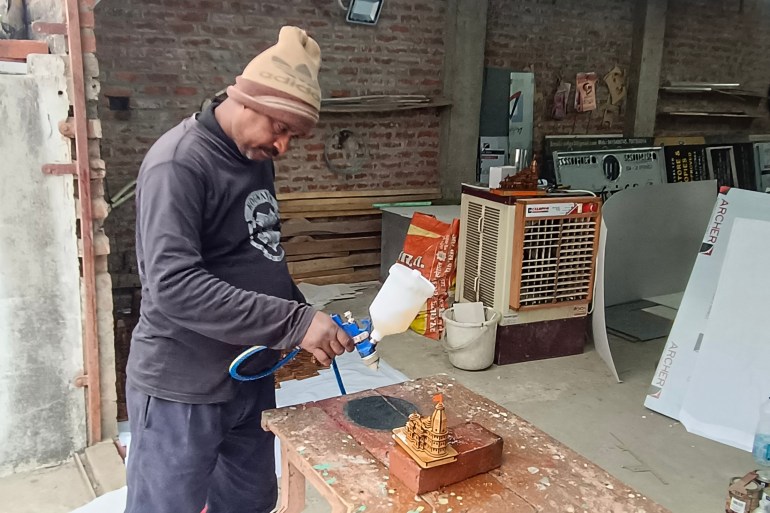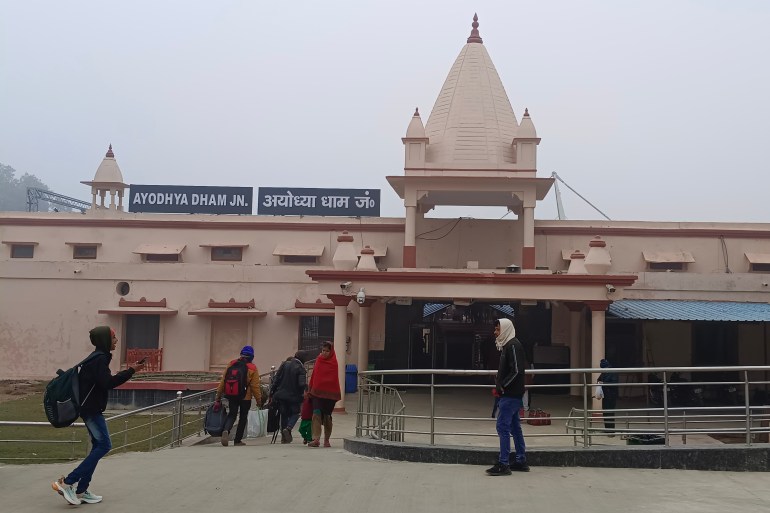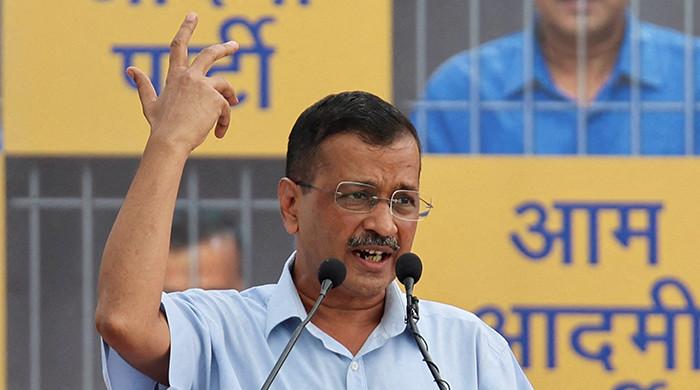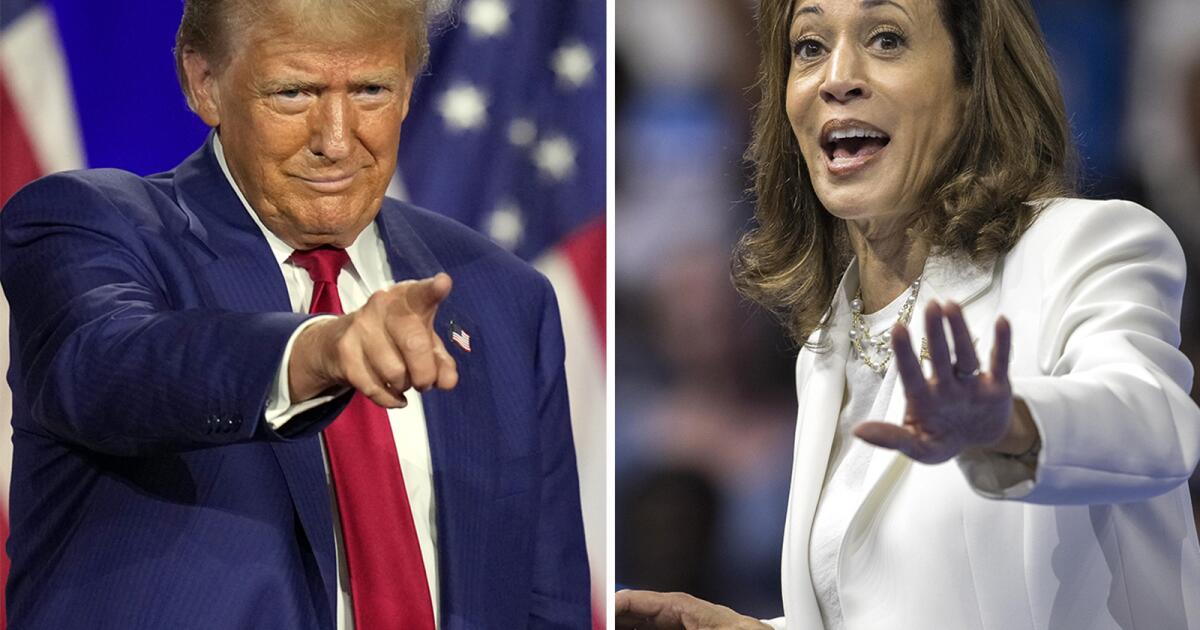Ayodhya, India – A 13-kilometre stretch around the controversial Ram temple in the northern Indian city of Ayodhya is illuminated with bright lights and the walls of the area covered in murals as the city prepares for the inauguration ceremony on January 22 by Prime Minister Narendra Modi.
But Rajesh Majhi has no time to enjoy the beauty of the city as he works overtime to print banners to be used in roadside advertisements for the consecration ceremony. He is also behind huge orders for miniature wooden-carved replicas of the Ram temple, which is currently under construction.
The 38-year-old says his business has increased almost 30 per cent in the last six months. “I have been in business for the past 12 years, but I have never witnessed such a huge demand for banners. There has been an increase in visits by important personalities and religious activities in the city in recent months,” he told Al Jazeera.
His monthly orders for banners have doubled to 60,000 from a year earlier, and he has opened a manufacturing unit to make replicas of the Ram temple, a new line of business for him, he said.
“We manufacture between 4,000 and 5,000 pieces each month, but demand is greater than supply. Traders are willing to pay any price and buy them because of that gap between supply and demand,” he said.
Kamal Kaushal, 62, who sells utensils in the city, about seven kilometers from the temple, is also happy with the rapid growth of his business.
“I have been running my store since 1978, but I have never come across such massive demand for utensils used in religious activities. Earlier, it was even difficult to sell one lakh rupees. [$1,206] value of utensils in a year. But now I have earned three lakh rupees. [$3,618] sales in the last year. We hope to witness more trekking once the Ram temple opens to the public.”
The duo is not alone, as several thousand traders from the region have been doing brisk business since construction of the temple began in 2020, months after India's Supreme Court handed over control of the disputed religious site in 2020. .77 acres to the Hindus. The burst of economic activity is expected to solidify support for Modi among local traders in the upcoming national elections.
Infrastructure boost
With the construction of the temple underway, the district with a population of around 2.5 million has witnessed a series of activities by the central and state governments, both led by the right-wing Bharatiya Janata Party (BJP), which They spare no effort. to give a grand look to the city and make it a great spiritual center in the country before the national elections to be held later this year.
Around 178 projects worth around 305 billion rupees ($3.6 billion) have been initiated, including a Ram temple-inspired railway station, an international airport, a modern township (the area of which has been demarcated) , widened roads and decorative streetlights.
Merchants are prepared for the increase in business expected due to the increase in tourists.
“We have suffered a lot in the last three decades since the movement for the construction of the Ram temple intensified in the 1980s, as there were frequent strikes and shutdowns called by different groups. [over] build the temple,” said Sushil Jaiswal, coordinator of a local business forum that includes 15,000 traders in Ayodhya district.
“Even after the Supreme Court verdict, the development works that started with road widening and construction of sewage system have affected our business for the last three years,” he added. “But now we hope for a better future as… it is becoming the business center of the state because of the temple.”
The government has also given a Geographical Indication (GI) tag to besan laddus or gram flour sweets offered as prasad to the god.
There are around 500 shops located within just a kilometer of the temple selling gram flour sweet to devotees.
Shakti Jaiswal, 38, who runs a sweet shop about 400 meters from the Ram temple, is hopeful that the label will help her improve her business.
“Counter sales will definitely improve with the influx of tourists who will see an increase after the consecration ceremony. The GI tag will help us take our business online, reach new markets and create more revenue opportunities,” he stated.
Vishal Singh, vice-chairman of the Ayodhya Development Authority (ADA), involved in infrastructure development, told Al Jazeera that the government aims to create a massive livelihood with the temple.
“Growth in the hospitality sector is witnessing reverse migration as people working in other cities or states are returning here… and 50 new hotels have been sanctioned,” he said.
Tourism will be the biggest benefactor

Tourism is considered to be the most profitable sector of the Ram temple as footfall is expected to increase considerably in the city, especially with a new airport and daily flights to the Indian capital and other places being added to a fast pace.
To cater to the expected influx of tourists, the state government sanctioned Rs 1 billion ($12.05 million) in the last financial year, money that is being spent on renovating several temples and other recreational places in the city, Rajendra Prasad said. Yadav, deputy director of tourism, Ayodhya division.
The number of visitors has increased since the Supreme Court ruling in 2019 and last year around 20 million people visited Ayodhya, a figure that is likely to double this year, he added.
There are already 175 big and small hotels in the city, and the state government has approved 500 new guest houses with a maximum of five rooms that are expected to be a source of income for locals, Yadav said.
While serving meat or alcohol is prohibited within a 5-kilometer (3-mile) radius of the temple, which is soon expected to expand to 15 kilometers (9 miles), hotels are optimistic that tourist numbers will make up for the drop. in the income from those lucrative offers.
In addition, the government is providing a 25 percent subsidy to those who build hotels, restaurants and recreational places with the aim of attracting more tourism, he said.
Arvind Awasthi, deputy vice-chancellor of Lucknow University, told Al Jazeera that the state's economy grew 14.3 per cent in the last financial year ending March 2023 and is expected to rise to 19 per cent in the fiscal year. today, partly thanks to the economic boom in Ayodhya.
“The spillover effect of business boom in Ayodhya would also be visible in other parts of the state. Wages and economic migration will increase as people consider the holy city as one of the main places of employment generation,” he said.

But business is not good for everyone. Large sections of traders have complained that around 1,000 shops in a 5-km area of the temple were demolished when the administration took up a road widening project and that the compensation they received was much less than the current real estate prices.
Vaibhav Gupta, 34, a sweet seller, said two of his four sweet shops were demolished when city officials tried to widen the road leading to the temple and his sales have halved because of that loss of business. location.
“They paid us [1.8 million rupees; $21,735] compensation for both stores, but the administration now demands [two million rupees; $24,149] for allocating us a single shop somewhere else, which is too much for poor traders like us.”
Singh of the Ayodhya Development Authority dismissed the allegations and said adequate compensation as per government norms was paid to traders whose shops were razed for development work.












